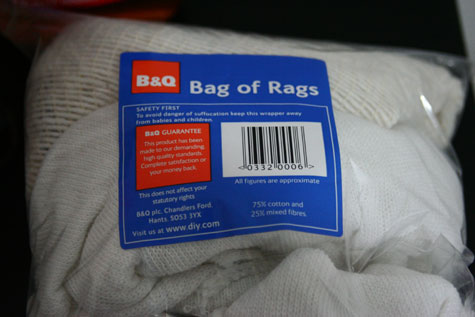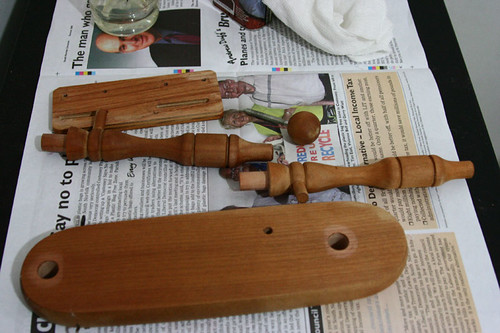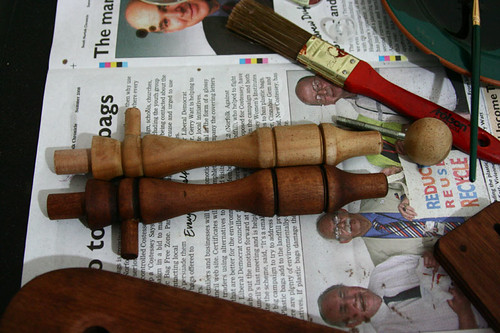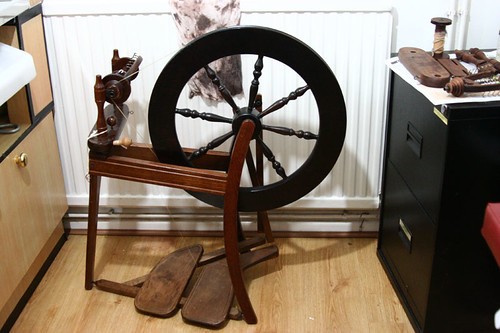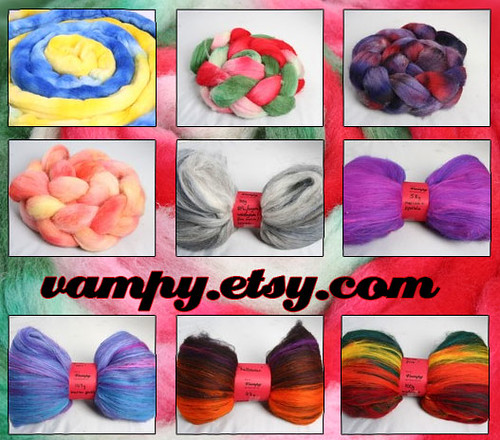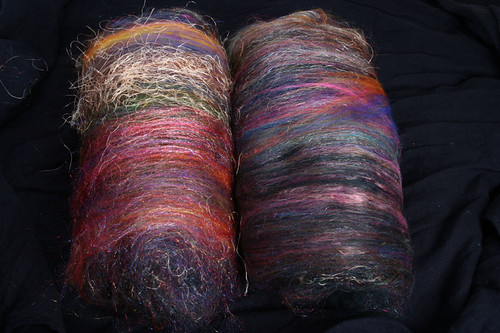Today, the postman brought me exciting post. Now, i love my postman, not only is he called Postman Pete, he doesn’t wake me with the doorbell, he just leaves my parcels in the garage. I’ve been waiting for a couple of things from overseas for a while now, and I’ve been checking my garage daily, but no luck. Then today, when I was on my way out to run errands, I looked into the garage, and there was stuff there….and look what I got!!!

There’s a whole kilogram of undyed sock yarn from these people (which only took 8 days to arrive from Hong Kong!), a big 100g bag of cashmere from Claire, and some Kureyon sock yarn.
 I am currently babysitting my parents’ kittens, so dyeing of yarn was out of the question with them running around all over the place, so I decided to sort out the Kureyon. From what I’d read online, I was expecting it to be very hard and scratchy, which it wasn’t really. Sure, for £10 a ball you might expect better, it’s no Jitterbug, but it felt pretty much as I’d expect a singles yarn in a medium fineness wool to feel. Regardless, I decided to skein it up and condition it, as much to check for knots as anything else. There was only one knot in the ball, which I suppose isn’t too bad for Noro, but there were LOTS of tangles that needed undoing. On a plied yarn, pulling hard probably would have been enough to untangle, but being a singles this yarn seemed fragile and I was too scared of breaking it.
I also measured the yarn as I skeined it, more out of habit than anything else, and was surprised to find I had 464m of it (and 97g). The ball band states ~ 100g/420m, so this is a fair way off. There was the odd thick patch, but no thinner than normal bits, so I’m sure this won’t impact on the end result, though I’ll probably use smaller needles than recommended. Â
Once the yarn was skeined, I soaked it in hot water with hair conditioner for half an hour or so, then treated it as I would handspun; I dunked it alternately in hot and cold water, and whacked it around a little, rolled it in a towel to get the water out, then snapped between my wrists. The theory being, if the yarn is abused now, it’ll get any shrinking out of the way so the end product stays as knitted. Oh, and I put a glug of vinegar in the final rinse water, as I wasn’t sure of the pH of my hair conditioner.
Here’s a pic of the yarn drying (click to enlarge). Mmmmmm. It looks so pretty, all the tangles were worth it.

I wanted to save the cashmere for something special, rather than wasting it just spinning for fun, but then I spoke to Claire and found out she had more if I needed it, so I decided to have a play with it. The staple length is very short, the auction said it was for “Laps (this is the ends from the spinning mills which will need to be recarded for spinning.)” I’ve no idea how they are made, it looks like many layers of fibres were built up, and then punched with a big hole punch, and these are the bits that come out. Here’s a pic (all the pics from now on are clicky):

Notice the kitten bite marks in the end of the tape measure? And yeah, the short staple length. I’d have pulled a few fibres out to show them, but they are so fine they are almost invisible to the naked eye. I carded up a small amount and tried to spin. It was a disaster. I knew with the short staple length I’d have to spin longdraw, but it just kept breaking and then the end would get sucked into the orifice and I’d be cursing at it while trying to find the end and keep a kitten from putting his paw in the flyer.
So I decided to add tussah silk. I am of the firm opinion that any fibre can be improved by the addition of tussah silk. Here’s some pics of the carding process.


 |
1) cashmere lumps on carder. I always put longer stapled stuff on with the ends of the locks hanging over the edge of the carder, even though this was short fluffy stuff, I still put it in the same place as normal.
2) tusssah silk on top, a very small amount
3) stopping to watch oliver cat attacking a towel
4) carded fibres. If you don’t know how to use carders, there is an awesome explanation here. In fact her whole blog is awesome, what are you doing reading my blog? hers is about a million times better. seriously, check it out.
5) pretty rolags |
The rolags probably had around 10% silk, hardly anything really, but just enough to give me a few longer stapled fibres to hold the cashmere together. I also had a minor epiphany while spinning and realised that while i can do huge arm’s length drafts when I’m spinning wool longdraw, I can’t do that with cashmere, I need to scale down my movements in proportion to the staple length, so drafts of 6-12″ work a lot better here. I was also not doing proper english longdraw, I have no idea what I was actually doing, other than it involved both hands, the back hand doing the drafting as usual, but the front hand smoothing out lumps and supporting the yarn.
I only spun up a couple of rolags before plying, I just wanted to see what the end result would be like, and here it is, hot off the wheel:

It’s not very exciting looking, being just a browny colour, but that’s about 20 metres of 2 ply laceweight, and it’s awesomely soft. Since taking the photo I’ve soaked and abused it, and it’s started to bloom nicely. Oh, and another amazing thing…I spun almost exactly the same length of yarn for each ply…I only had one inch left over on one of the bobbins at the end…I was shocked!
 The very very observant of you might have noticed in the bottom corner of the photo of oliver, you can see this book, which i borrowed from the library today, as I am trying to learn to weave, after getting a loom from Nik for my birthday. It’s not actually my birthday yet, but I still have my loom, and a bag of sticks and bits of stuff I have no idea what they do. I will write about it on here at some point, but this entry is long enough for now!



